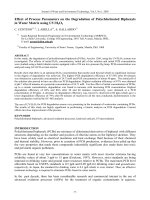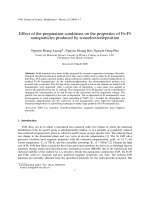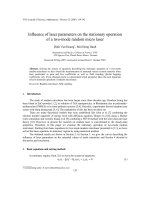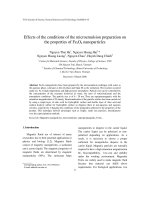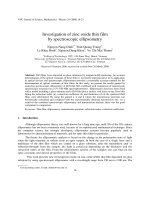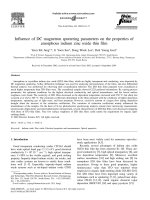influence of DC magnetron sputtering parameters on the properties of amorphous indium zinc oxide thin film y s jung
Bạn đang xem bản rút gọn của tài liệu. Xem và tải ngay bản đầy đủ của tài liệu tại đây (775.9 KB, 9 trang )
Thin Solid Films 445 (2003) 63–71
0040-6090/03/$ - see front matter ᮊ 2003 Elsevier Science B.V. All rights reserved.
doi:10.1016/j.tsf.2003.09.014
Influence of DC magnetron sputtering parameters on the properties of
amorphous indium zinc oxide thin film
Yeon Sik Jung *, Ji Yoon Seo , Dong Wook Lee , Duk Young Jeon
a, aab
R & D Center, Samsung Corning, 644, Jinpyoung-dong, Gumi, Kyoung-buk 730-725, South Korea
a
Department of Materials Science and Engineering, Korea Advanced Institute of Science and Technology, 373-1, Kusong-dong, Yusung-gu,
b
Taejon 305-701, South Korea
Received 16 December 2002; received in revised form 8 July 2003; accepted 4 September 2003
Abstract
Amorphous or crystalline indium zinc oxide (IZO) thin films, which are highly transparent and conducting, were deposited by
DC magnetron sputtering. X-Ray diffraction technique was used for analyzing microstructures of the films, and also differential
thermal analysis was performed for observing their crystallization behavior. The IZO thin films prepared were crystallized at
much higher temperature than ITO films were. The crystallized samples showed (222) preferred orientations. By varying process
parameters, the optimum conditions for the highest electrical conductivity and optical transmittance, and the lowest surface
roughness were found. The resistivity of IZO films decreased as the deposition temperature increased until 250 8C, but sharp rise
occurred at or above 300 8C. The extinction coefficients diminished in the films prepared with the conditions of higher deposition
temperature, sputtering gas of light mass, and heat treatment. However, excessive amount of oxygen flow during deposition
brought about the increase of the extinction coefficients. The variations of extinction coefficients mainly influenced the
transmittance of the samples. On the basis of X-ray photoelectron spectroscopy analysis, atomic force microscopy measurement,
spectroscopic ellipsometry and spectrophotometer measurement, several characteristics of IZO thin films were discussed comparing
with those of ITO thin films. Very low surface roughness of IZO thin films could satisfy the requirement for organic light-
emitting diode.
ᮊ 2003 Elsevier Science B.V. All rights reserved.
PACS: 68.55 a; 73.61 r; 78.66 w
Keywords: Indium oxide; Zinc oxide; Electrical properties and measurements; Optical properties
1. Introduction
Good transparent conducting oxides (TCOs) should
have wide optical band gap ()3.5 eV), good electrical
conductivity ()10 V cm ), high optical transpar-
3 y1 y1
ency ()80% in the visible region), and good etching
property. Impurity-doped indium oxides, tin oxides, and
zinc oxides systems are known to satisfy these condi-
tions well
w
1–3
x
. Especially, impurity-doped indium
oxide systems such as tin-doped indium oxide (ITO)
*Corresponding author. Present address: Korea Institute of Science
and Technology, Thin Film Materials Research Center, Cheongryang,
P.O. Box 131, Seoul 136-791, South Korea. Tel.: q82-2-958-6851;
fax: q82-2-958-6851.
E-mail address: (Y.S. Jung).
have been most widely used for numerous opto-elec-
tronic applications
w
4,5
x
.
Recently, several advantages of indium zinc oxide
(IZO) thin film has been reported
w
6–10
x
. These are:
good conductivity
w
7
x
, high optical transparency
w
8
x
, and
low deposition temperature
w
9
x
. Moreover, excellent
surface smoothness
w
10
x
and high etching rate
w
9
x
for
amorphous IZO thin films have been discussed by
researchers. Owing to these good properties, higher
luminescence value than ITO was reported when
employed in organic light-emitting diode (OLED)
w
10
x
.
The IZO films have been deposited using variety of
techniques such as sputtering
w
7,11
x
, pulsed laser depo-
sition (PLD)
w
12,13
x
, metal organic chemical vapor
deposition (MOCVD)
w
14
x
and spray pyrolysis
w
15
x
.
64 Y.S. Jung et al. / Thin Solid Films 445 (2003) 63–71
Table 1
Process conditions for depositing IZO thin films (Unspecified units are sccm)
࠻ Ar O
2
Ne Xe Power Sub. temperature Resistivity R
rms
Structure
(kW)(8C)(mVcm)(A)
˚
1400 – – 2 R.T. 509 2.05 Amorphous
2400.5 – – 2 R.T. 545 2.43 Amorphous
3401 – – 2 R.T. 531 2.25 Amorphous
4402 – – 2 R.T. 1760 3.07 Amorphous
5405 – – 2 R.T. r 2.12 Amorphous
6400 – – 2 150 378 2.49 Amorphous
7400 – – 2 200 363 2.31 Amorphous
8400 – – 2 250 361 2.19 Amorphous
9400 – – 2 300 403 4.27 Amorphous
10 40 0 – – 2 350 693 12.1 Crystalline
11 40 0 – – 1 R.T. 459 – Amorphous
12 40 0 – – 3 R.T. 626 – Amorphous
13 – – 40 – 2 R.T. 455 – Amorphous
14 – – – 40 2 R.T. 535 – Amorphous
The purpose of this paper is to describe a detailed
investigation of the influence of DC magnetron sputter-
ing parameters including deposition temperature, oxygen
flow rate, sputtering power and sputtering gas, on the
structural and physical properties of IZO thin films. To
do so, several analytical tools such as X-ray diffraction
(XRD), differential thermal analysis (DTA), atomic
force microscopy (AFM), X-ray photoelectron spectros-
copy (XPS), Hall measurement system, spectroscopic
ellipsometer and spectrophotometer were used for the
characterization of the prepared samples.
2. Experiments
The IZO thin films were sputter-deposited using an
indium zinc oxide target in an in-line magnetron sputter
deposition system equipped with DC power suppliers
(SPL-300, ULVAC)
w
16
x
.
The chamber, which was equipped with a load-lock
system and diffusion pumps, had a base pressure of
5=10 Torr. The targets (128=450 mm) used were
y6
sintered IZO containing 10 wt.% ZnO (Idemitsu Kosan).
The sputtering was carried out at a pressure of
3=10 Torr in pure Ar or AryO gas mixture with
y3
2
varying sputtering parameters such as oxygen flow rate,
deposition temperature and sputtering gas.
The films were deposited on glass substrates (Corning
1737), which were placed 50 mm apart and parallel
from the target surface. The substrates were cleaned in
an ultrasonic bath in 4% Deconex 12PA at 65 8C for 6
min, and then rinsed in deionized water in the ultrasonic
bath for another 15 min. The target was pre-sputtered
for 3 min. Oxygen flow rate was 0–5 sccm, sputtering
power was 1–3 kW, and the substrate temperature varied
from room temperature to 350 8C. The dynamic depo-
sition rates of the samples were approximately 50–150
nm=mymin depending upon deposition conditions.
Heat treatment was performed under different gaseous
atmospheres (vacuum, CO, O ) for an hour, and cooled
2
to room temperature in the ambient.
Most of the samples characterized were 140 nm thick.
XRD studies on the films were carried out in a Philips
PW1710 diffractometer using Cu Ka radiation (
l
s
154.05 pm) at 30 kV and 20 mA. The root-mean-square
roughness (R ) was determined, and surface images
rms
were taken by atomic force microscopy (AFM, Auto-
probe M5, PSIA company), and the scan area was
20=20 mm . For differential thermal analysis (DTA,
2
DSC2920, TA Instruments), the IZO thin film of the
thickness of 1 mm was coated on a p-type (100) Si
wafer. X-Ray photoelectron spectroscopy (XPS) meas-
urements were performed using a VG ESCALAB 200
R electron spectrometer. The pressure in the analysis
chamber was approximately 1=10 Torr. The surface
y10
XPS data were collected using monochromatic Mg Ka
radiation (1253.6 eV) operating at 250 W. The concen-
tration and the mobility of electrons were measured
using Hall effect and Van der Pauw’s technique with
magnetic field of 0.320 T. The indices of refraction as
well as the extinction coefficients of the films were
determined in the wavelength range of 300–1000 nm
by using a spectroscopic ellipsometer (VASE, J.A.
Woollam Co., Inc.). The optical transmittance was meas-
ured in the wavelength range of 300–800 nm by UVy
VISyNIR spectrophotometer (Lambda19, PERKIN–
ELMER).
3. Results and discussions
3.1. Structural and morphological properties
Fig. 1a shows the change of XRD pattern in the range
of 2
u
s10–808 as the substrate temperature increased.
The IZO films deposited at temperatures below 350 8C
were amorphous, whereas the XRD profile of the sample
deposited at 350 8C showed a sharp (222) peak at 2
u
s
65Y.S. Jung et al. / Thin Solid Films 445 (2003) 63–71
Fig. 1. XRD spectra taken from IZO thin films deposited on glass
substrates depending upon (a) deposition temperature and (b) heat
treatment temperature.
Fig. 2. DTA curves of a bare Si wafer and an IZO thin film deposited
on Si wafer.
30.58, indicating that the film was polycrystalline. Poly-
crystalline ITO thin films have been reported, which
were deposited at slightly higher than 150 8C
w
17
x
or
even at room temperature under low pressure
w
18
x
.
However, for obtaining crystallized IZO thin films,
temperatures over 300 8C were required. ITO thin films,
which are deposited at higher deposition temperatures
than 300 8C with low oxygen partial pressure, are known
to have a strong (400) XRD peak at approximately
2
u
s35.58
w
19
x
. However, Fig. 1a indicates that (222)
orientation is highly dominant for the IZO thin film.
Some papers about IZO thin films deposited by sputter-
ing
w
11
x
, PLD
w
13
x
and MOCVD
w
14
x
also reported
dominance of the (222) orientation. Fig. 1b shows the
change of XRD profiles as the heat treatment tempera-
ture increased. Heat treatment was performed in a
vacuum chamber for 60 min. No XRD peak was found
below the temperature of 500 8C, while a strong (222)
XRD peak was observed in the sample annealed at 600
8C. Usually, amorphous ITO thin films are crystallized
with the preferred (222) orientation after heat treatment
w
17,20
x
. Depending upon their wettability on the sub-
strate, nuclei are classified into two types, wetting mode
and non-wetting mode. The wetting-mode nuclei have a
preferred orientation that minimizes the surface energy
of the film, whereas the non-wetting mode nuclei have
random orientations and spherical shapes
w
21
x
.
{
111
}
planes, which are the mostly dense-packed planes in
In O of c-type rare-earth structure, have the lowest
23
surface energy. That can explain the formation mecha-
nism of the (222) preferred orientation of heat-treated
IZO or ITO thin films. Song et al. reported that pure
In O amorphous thin films were crystallized by anneal-
23
ing at 150–160 8C, but the crystallization of ITO thin
films needed the temperature of 180–190 8C, which
was approximately 30 8C higher than that for pure
In O amorphous thin films
w
17
x
. They assumed that
23
this might be due to the substitution of Sn ions for
4q
In ions. Minami et al. reported that the peak intensity
3q
of XRD pattern decreased as the Zn concentration
increased
w
11
x
, which means the decline of crystallinity.
The Zn ions in the IZO thin films seem to increase
2q
the energy barrier for the diffusion of atoms in the film,
and hence disturb the rearrangement of atoms. Fig. 2
shows the DTA curves for a bare and an IZO-coated
silicon wafer. No peak was found for the bare wafer but
a small exthothermic peak was observed in the range of
500–600 8C for the IZO-coated sample. So the crystal-
lization temperature (T ) of amorphous IZO thin film
c
seems to be between 500 and 600 8C, which confirms
the XRD results. The reason of the small height of the
peak seems to be that the IZO thin film was as thin as
1 mm, whereas the thickness of the wafer was as large
as 450 mm.
The change of surface roughness of IZO samples
deposited on silicon wafers without additional oxygen
gas is shown in Fig. 3a. The roughness values and
images were measured with AFM. The R values were
rms
not changed sharply for the RT-200 8C samples, but
increased significantly for the sample deposited at 350
66 Y.S. Jung et al. / Thin Solid Films 445 (2003) 63–71
Fig. 3. (a) Surface roughness change depending upon deposition tem-
perature and three-dimensional images of IZO films deposited at (b)
RT and (c) 350 8C.
Fig. 4. Changes of (a) In3d, (b) Zn2p and (c) O1s XPS spectra of
IZO thin films as a function of oxygen flow rate.
8C, The AFM images illustrated in Fig. 3b,c support
these values. The surface of the samples deposited at
relatively low temperatures was so flat that their R
rms
was as low as 2 A. This might be due to the fact that
˚
the IZO thin films were amorphous containing no
crystalline phases. But the sample deposited at 350 8C
was of polycrystalline phase, so it had a rough surface.
OLEDs demand ultra-flat TCOs, and hence IZO needs
to be deposited at temperatures below 250 8C to obtain
satisfactory flatness for OLED applications. There was
no significant change of roughness in the samples
deposited at room temperature depending upon O flow
2
rate (Table 1).
3.2. XPS analysis
Fig. 4a–c show the XPS peaks of In3d, Zn2p and
O1s, respectively. The samples were deposited with
different oxygen flow rates at room temperature. The
detailed deposition conditions (sample numbers: 1, 3, 4
and 5) are specified in Table 1. Fig. 4a,b indicates no
67Y.S. Jung et al. / Thin Solid Films 445 (2003) 63–71
Fig. 5. Variations of the resistivity, the carrier concentration and the mobility of IZO films depending upon (a) oxygen flow rate, (b) sputtering
power, (c) substrate temperature and (d) heat treatment atmosphere.
noticeable change for the In3d and Zn2p peaks, however,
the O1s peaks evolved to one peak with increasing
oxygen flow rate. John et al. distinguished the two peaks
in O1s XPS results of ITO films
w
22
x
. They assumed
that the peak with larger binding energy and smaller
height was originated from the oxygen in oxygen-
deficient region. Namely, they explained that smaller
electron charge density in the region of oxygen vacancy
reduced the screening effect, thus raising the effective
nuclear charge
w
22
x
. Fig. 4c shows that the O1s peaks
with higher and lower binding energy are at 531 eV and
529.5 eV, respectively. The intensity of the peak with
higher binding energy decreased as the oxygen flow rate
increased, and the higher-energy peak was not detected
for the sample of oxygen flow rate of 5 sccm. These
results agree well with the report of John et al. Because
the number of oxygen vacancy decreased as the oxygen
flow rate increased, the intensity of higher-energy peak
decreased.
3.3. Electrical properties
N-type conductivity of IZO has been reported by
many authors
w
7,8,11,13,23
x
. Naghavi et al. explained
that the n-type conduction is due to free electrons from
oxygen vacancies. Moreover, they reported that electrical
conductivity decreased as the temperature increased,
which is typical of degenerate semiconductor materials
w
23
x
. The concentration and Hall mobility of electrons
increased by increasing Zn content until ZnyIns0.33
w
24
x
. N. Naghavi explained that electronic localized
levels introduced by Zn impurities might overlap the
2q
bottom of the conduction band, thus the Hall mobility
could be enhanced by the addition of Zn to In O
w
13
x
.
23
The Hall measurement results of the IZO samples
prepared with varying sputtering parameters are shown
in Fig. 5. Fig. 5a presents the change of carrier concen-
tration, the mobility and the resistivity of the samples
with different oxygen flow rate. The resistivity did not
change much by increasing oxygen flow rate until 1
sccm, but increased very sharply above 1 sccm. The
sample with the oxygen flow rate of 5 sccm was not
conducting (Table 1). Hall mobility increased slightly
by increasing oxygen flow rate, but the concentration of
electrons decreased significantly by increasing oxygen
flow rate over 1 sccm. Hence, a large change in
resistivity occurs at )1sccm. This is the similar tenden-
cy to other TCOs such as ITO
w
19
x
. Thus, the lowest
resistivity was obtained for the samples without adding
oxygen gas. However, most of the published papers
dealing with ITO or IZO reported that the lowest
resistivity was obtained by adding small amount of
68 Y.S. Jung et al. / Thin Solid Films 445 (2003) 63–71
oxygen gas
w
13
x
. This may be due to the differences in
the sputtering systems or the oxydation status of target
materials. It could also be stem from the background
gas level from out gassing. Fig. 5b shows that the
resistivity values of the samples increased with sputter-
ing power by the decrease of the carrier concentration.
Shigesato et al. also reported the same tendency of
resistivity of ITO thin films
w
25
x
. It was proposed that
the kinetic energy of negatively charged O ions
y
increases as sputtering power, so higher sputtering power
can enhance the lattice damage by the high-energy ions.
That might deteriorate the crystallinity of the films, and
reduce the concentration of electrically active donor
sites.
Fig. 5c shows that the resistivity decreases as the
deposition temperature increased until approximately
250 8C, but sharp rise appears at above 300 8C. The
electron density increased until approximately 250 8C,
but decreased at higher temperatures. These may be
caused by two opposite factors in the electron density
of the films. Firstly, as the deposition temperature
increased from RT, absorbed oxygen atoms on the film
surface may be more easily desorbed than indium or
zinc atoms since oxygen have much lower boiling point
and higher vapor pressure than indium or zinc metals
w
26
x
. This will lead to decreased oxygen content and
increased number of oxygen vacancies in the films as
the substrate temperature increases. Secondly, Zn ions
2q
may acquire sufficient activation energy for occupying
In sites at high deposition temperatures, which results
3q
in higher solubility of Zn. It was reported that the
solubility of Sn increased as the deposition temperature
of ITO increased
w
27
x
. Increased amount of the n-dopant
Sn ions produces more free electrons, but the p-
4q
dopant Zn ions supply holes because of the difference
2q
in valences of Zn (q2),In(q3) and Sn (q4). This
effect will result in the decrease of electron density in
the films with high deposition temperatures. The
increased scattering events of electrons with the supplied
holes at high deposition temperatures may be responsible
for the decrease of carrier mobility. The dominance of
the first mechanism seems to cause the increase of
electron density in the range of RT-250 8C. In this
range, the increase of carrier mobility is attributed to
the improvement of crystallinity. In contrast, above 250
8C, Zn-doping on indium sites may be promoted by
sufficient activation energy. It could be a possible
explanation for the decrease of resistivity at or above
250 8C.
Meanwhile, it was reported that the conductivity of
the IZO films, deposited by PLD technique with
Zn In O targets which contain more zinc than indium,
326
increased until over the deposition temperature of 500
8C
w
8
x
. The IZO film of this Zn composition has
different crystallographic structure of Zn In O from
k 2 kq3
In O structure
w
24
x
. In this case, In ions can occupy
q3
23
Zn sites, so more free electrons can be generated in
2q
this way. The Hall measurement results of the heat-
treated samples are shown in Fig. 5d. The as-deposited
sample was deposited at room temperature without
additional oxygen gas. The deposition power was 2 kW.
The heat treatment was carried out at 300 8C for 1 h
under different gaseous atmospheres. The mobility val-
ues of all the samples increased after the heat treatment,
and it seemed to be due to the improvement of crystal-
linity especially for the sample heat-treated under oxy-
gen atmosphere where oxygen can be supplied to the
inside of amorphous IZO films. The decreased n-type
carrier density after heat-treatment may be the evidence
of p-type doping by Zn. More significant decrease in
electron concentration of the sample annealed under
oxygen gas may be due to lowered number of oxygen
vacancies. Furthermore, decrease of electron density in
the presence of CO gas than in vacuum may be due to
undesirable chemical reaction between the gas and the
sample. The decreased amount of carrier density after
heat treatment at 300 8C was lowest for vacuum condi-
tion. Consequently, vacuum was the best for low resis-
tivity at 300 8C.
3.4. Optical properties
The indices of refraction (n) and extinction coeffi-
cients (k) of IZO thin films, which were deposited under
varied sputtering conditions, were determined from spec-
troscopic ellipsometry data applying a model combining
Drude and Lorentz terms. Fig. 6a,b present the increase
of n, k values as the oxygen flow rate increased. The
samples were deposited at room temperature with the
power of 2 kW. Some authors reported that the n, k
values of ITO samples were decreased by supplying
more oxygen gas during deposition
w
28
x
, but other
authors reported the opposite results
w
29
x
. The content
of zinc increased as the oxygen flow rate increased
w
8
x
.
The refractive index of ZnO film (ns1.95–2.1 in visible
range) is known to be higher than that of In O film
23
(ns1.6–2.0 in visible range)
w
30–32
x
. Moreover, the
increase of the Zn in the films might raise the degree
of disorder in the films and produce more optical
scattering centers. This might be a possible explanation
for the increase of n, k values, but further analyses
should be performed to account for these results more
clearly. Fig. 6c,d shows the change of n, k values as the
substrate temperature increased. The samples were
deposited at 2 kW without additional oxygen. The
electrical properties of the samples were shown in Fig.
5c. The k values of the samples showed more change
by varying deposition temperature than the change of n
values. The differences of n values in UV or IR range
may be due to the variation of dielectric functions of
the films depending upon the deposition parameters.
The change of k values depending upon deposition
69Y.S. Jung et al. / Thin Solid Films 445 (2003) 63–71
Fig. 6. Variations of indices of refraction and extinction coefficients depending upon (a), (b) oxygen flow rate, (c), (d) deposition temperature
and (e), (f) sputtering gas, respectively.
temperature can be associated with the differences in
the microstructure and electrical property. When the
TCOs of In O system are deposited at low temperature,
23
sub-oxide phases act as optical scattering centers
w
33
x
.
In this study, In O or ZnO phases in the IZO
23yx 1yx
films deposited at low temperature seem to lead to the
increase of k value. Thus, the IZO sample deposited at
350 8C showed much lower k values than other samples.
However, the sample deposited at 250 8C had higher k
values than the sample deposited at RT especially in the
IR region. The adsorption of transparent conducting ITO
films in the IR range is known to be due to free carriers
in the materials (Drude Edge)
w
34
x
. The electron con-
centration was highest in the sample deposited at 250
8C as shown in Fig. 5d.
Fig. 6e,f shows the variation of n, k values when the
deposition was performed using different sputtering
gases. The samples were deposited at room temperature
without additional oxygen. When Ne gas was used,
higher n values and lower k values were measured than
with Ar and Xe. When sputtering gases of higher mass
such as Xe are used for depositing ITO thin film, indium
70 Y.S. Jung et al. / Thin Solid Films 445 (2003) 63–71
Fig. 7. Transmittance curves depending upon (a) oxygen flow rate, (b) deposition temperature, (c) sputtering gas and (d) heat treatment
atmosphere.
atoms or other ion species from the sputtering target
lose more energy by collisions occurring among ions or
gas molecules than in the case using the gases of smaller
mass such as He
w
35
x
. Employing the explanation to
this study, in the case of using Ne gas, which has smaller
mass, sputtered species directed to the substrate lose
less energy during collisions, and hence the films have
better crystallinity and higher density. This might lead
to the increase of n and the decrease of k.
Usually, transmittance depends on n, k values. In this
study, k values were influenced much more than n
values by varying process conditions. The variation of
transmittance with different oxygen flow rate is shown
in Fig. 7a. The samples were deposited at room temper-
ature with the power of 2 kW. The lower transmittance
with higher oxygen flow rate can be expected from the
measured optical constants of the samples, as shown in
Fig. 6b. As proposed in Section 3.3, lower transmittance
with higher oxygen flow rate seems to be due to more
disorder in the films. Fig. 7b shows increased transmit-
tance as the deposition temperature increased. The sam-
ples were deposited at 2 kW without supplying oxygen
gas. Fig. 7c presents the sputtering gas of lower mass
led to better transmittance. The samples were deposited
at room temperature without additional oxygen gas.
Those results in Fig. 7b,c are also expected from the
measured extinction coefficients of the samples, as
shown in Fig. 6d,f. The variation of transmittance with
different atmosphere during thermal treatment is shown
in Fig. 7d. The as-deposited sample was deposited at
room temperature without additional oxygen gas. The
deposition power was 2 kW. The optical constants of
the samples were not measured, but higher electron
concentration may result in higher extinction coefficient
and adsorption. Actually, the sample annealed under
oxygen atmosphere had the lowest carrier density and
the highest transmittance.
4. Conclusions
In this work, amorphous or crystalline indium zinc
oxide (IZO) thin films were deposited on glass or Si
wafer substrates using DC magnetron sputtering tech-
nique. The IZO films deposited below 350 8C were of
amorphous phase, whereas the sample deposited at 350
8C was crystalline. For crystallization, the amorphous
IZO samples needed to be heat-treated at temperatures
over 600 8C, which is much more than the T of ITO.
c
71Y.S. Jung et al. / Thin Solid Films 445 (2003) 63–71
The crystallized samples showed the (222) preferred
orientations. The surface of the samples deposited at
temperatures below 350 8C were so flat that their R
rms
values were as low as 2 A, which could satisfy the
˚
requirement for organic light-emitting diode (OLED).
The samples of the lowest resistivity were deposited
at 250 8C without supplying additional oxygen gas, but
higher deposition temperature resulted in the increase of
resistivity because of the decrease of carrier concentra-
tion and Hall mobility. The refractive indices and extinc-
tion coefficients were changed depending upon process
conditions such as oxygen flow rate, deposition temper-
ature, and sputtering gas. Also, the conditions for higher
optical transmittance were discussed. Higher deposition
temperature, sputtering gas of light mass and heat
treatment resulted in decreased extinction coefficients
and increased transmittance. However, excessive amount
of oxygen flow during deposition brought about the
decrease of transmittance.
In conclusion, the IZO films deposited at 250 8C
without additional oxygen gas showed best electrical
properties, maintaining smooth morphology and fairly
high optical transmittance.
References
w
1
x
G. Haacke, Annu. Rev. Mater. Sci. 7 (1977) 73.
w
2
x
C.G. Granqvist, Appl. Phys. A 52 (1991) 83.
w
3
x
H. Sato, T. Minami, S. Takata, T. Miyata, M. Ishii, Thin Solid
Films 102 (1983) 1.
w
4
x
I. Hamberg, C.G. Grangvist, J. Appl. Phys. 60 (1986) R123.
w
5
x
S. Ishibashi, Y. Higuchi, Y. Ota, K. Nakamura, J. Vac. Sci.
Technol. A 8 (1990) 1403.
w
6
x
H. Takatsuji, S. Tsuji, K. Kuroda, H. Saka, Mater. Trans. 40
(1999) 899.
w
7
x
T. Minami, T. Kakumu, S. Takata, J. Vac. Sci. Technol. A 14
(1996) 1704.
w
8
x
N. Naghavi, A. Rougier, C. Marcel, C. Guery, J.B. Leriche,
J.M. Tarascon, Thin Solid Films 360 (2000) 233.
w
9
x
A. Kaijo, Display Imaging 4 (1996) 143.
w
10
x
W.J. Lee, Y K. Fang, J J. Ho, C Y. Chen, L H. Chiou, S J.
Wang, F. Dai, T. Hsieh, R Y. Tsai, D. Huang, F.C. Ho, Solid
State Electron. 46 (2002) 477.
w
11
x
T. Minami, T. Yamamoto, Y. Toda, T. Miyata, Thin Solid Films
373 (2000) 189.
w
12
x
J.P. Zheng, H.S. Kwok, Thin Solid Films 232 (1993) 99.
w
13
x
N. Naghavi, C. Marcel, L. Dupont, A. Rougier, J B. Leriche,
C. Guery, J. Mater. Chem. 10 (2000) 2315.
w
14
x
A. Wang, J. Dai, J. Cheng, M.P. Chudzik, T.J. Marks, R.P.H.
Chang, C.R. Kannewurf, Appl. Phys. Lett. 73 (1998) 327.
w
15
x
D.J. Goyal, C. Agashe, M.G. Tkwalc, V.G. Bhide, J. Mater.
Res. 8 (1993) 1052.
w
16
x
S. Ishibashi, Y. Higuchi, Y. Ota, K. Nakamura, J. Vac. Sci.
Technol. A 8 (1990) 1399.
w
17
x
P.K. Song, H. Akao, M. Kamel, Y. Shigesato, I. Yasui, Jpn. J.
Appl. Phys. 38 (1999) 5224.
w
18
x
A.K. Kulkarni, K.H. Schulz, T.S. Lim, M. Khan, Thin Solid
Films 345 (1999) 273.
w
19
x
C.G. Choi, K.N. No, W.J. Lee, H.G. Kim, S.O. Jung, W.J. Lee,
W.S. Kim, S.J. Kim, C. Yoon, Thin Solid Films 258 (1995)
274.
w
20
x
L J. Meng, F. Placido, Surf. Coat. Technol. 166 (2003) 44.
w
21
x
T.Q. Li, S. Noda, Y. Tsuji, T. Ohsawa, H. Komiyama, J. Vac.
Sci. Technol. A 20 (2002) 583.
w
22
x
J.C.C. Fan, J.B. Goodenough, J. Appl. Phys. 48 (1977) 3524.
w
23
x
N. Naghavi, C. Marcel, L. Dupont, A. Rougier, J B. Leriche,
C. Guery, J. Mater. Chem. 10 (2000) 2315.
w
24
x
N. Naghavi, L. Dupont, C. Marcel, C. Maugy, B. Laik, A.
Rougier, C. Guery, J.M. Tarascon, Electrochim. Acta 46 (2001)
2007.
w
25
x
Y. Shigesato, David C. Paine, Thin Solid Films 238 (1994)
44.
w
26
x
D.R. Lide, CRC Handbook of Chemistry and Physics, Chem-
ical Rubber Company Press, Boca Raton, FL, 2000–2001.
w
27
x
F. El Akkad, M. Marafi, A. Punnoose, G. Prabu, Phys. Status
Solidi A 177 (2000) 445.
w
28
x
W. Wu, B.S. Chiou, Thin Solid Films 298 (1997) 221.
w
29
x
H. Kim, J.S. Horwitz, A. Pique, C.M. Gilmore, D.B. Chrisey,
Appl. Phys. A 69 (1999) S447.
w
30
x
H. Gong, Y. Wang, Z. Yan, Y. Yang, Mater. Sci. Semicond.
Proc. 5 (2002) 31.
w
31
x
E.M. Bachari, G. Baud, S. Ben Amor, M. Jacquet, Thin Solid
Films 348 (1999) 165.
w
32
x
W F. Wu, B S. Chiou, Thin Solid Films 298 (1997) 221.
w
33
x
Y. Shigesato, D.C. Paine, T.E. Haynes, Jpn. J. Appl. Phys. 32
(1993) L1352.
w
34
x
R.A. Synowicki, Thin Solid Films 313 (1998) 394.
w
35
x
P.K. Song, Y. Shigesato, I. Yasui, C.W. Ow-Yang, D.C. Paine,
Jpn. J. Appl. Phys. 37 (1998) 1870.
